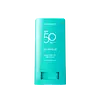What's inside
What's inside
 Key Ingredients
Key Ingredients

 Benefits
Benefits

 Concerns
Concerns

 Ingredients Side-by-side
Ingredients Side-by-side

C12-15 Alkyl Benzoate
AntimicrobialOctocrylene
UV AbsorberHomosalate
Skin ConditioningSilica
AbrasiveBis-Ethylhexyloxyphenol Methoxyphenyl Triazine
Skin ConditioningPolyethylene
AbrasiveTribehenin
EmollientDimethicone/Vinyl Dimethicone Crosspolymer
Skin ConditioningIsohexadecane
EmollientEthylhexyl PCA
HumectantMea-Salicylate
PreservativeButyl Methoxydibenzoylmethane
UV AbsorberButyloctyl Salicylate
Skin ConditioningDimethicone
EmollientPolymethyl Methacrylate
Phenoxyethanol
PreservativeTocopheryl Acetate
AntioxidantEthylhexylglycerin
Skin ConditioningTocopherol
AntioxidantParfum
MaskingC12-15 Alkyl Benzoate, Octocrylene, Homosalate, Silica, Bis-Ethylhexyloxyphenol Methoxyphenyl Triazine, Polyethylene, Tribehenin, Dimethicone/Vinyl Dimethicone Crosspolymer, Isohexadecane, Ethylhexyl PCA, Mea-Salicylate, Butyl Methoxydibenzoylmethane, Butyloctyl Salicylate, Dimethicone, Polymethyl Methacrylate, Phenoxyethanol, Tocopheryl Acetate, Ethylhexylglycerin, Tocopherol, Parfum
Water
Skin ConditioningEthylhexyl Methoxycinnamate
UV AbsorberButylene Glycol Cocoate
EmulsifyingButylene Glycol
HumectantPhenoxyethanol
PreservativeButyl Methoxydibenzoylmethane
UV AbsorberSodium Acrylates Crosspolymer-2
AbsorbentIsostearyl Alcohol
EmollientTitanium Dioxide
Cosmetic ColorantAcrylates/C10-30 Alkyl Acrylate Crosspolymer
Emulsion StabilisingOctocrylene
UV AbsorberSodium Hyaluronate
HumectantTriethanolamine
BufferingHydrolyzed Wheat Protein/Pvp Crosspolymer
Sodium Hydroxide
BufferingTetrasodium EDTA
Ethylhexylglycerin
Skin ConditioningPropylene Glycol
HumectantAlumina
Abrasive1,2-Hexanediol
Skin ConditioningOleth-10
EmulsifyingPolysorbate 60
EmulsifyingStearic Acid
CleansingAroma
Glycerin
HumectantLecithin
EmollientEthylcellulose
Prunus Amygdalus Dulcis Seedcoat Powder
AbrasivePotassium Sorbate
PreservativeDisodium EDTA
Schisandra Chinensis Fruit Extract
Skin ConditioningDecyl Glucoside
CleansingAloe Barbadensis Leaf Extract
EmollientBenzoic Acid
MaskingCamellia Sinensis Leaf Extract
AntimicrobialCitric Acid
BufferingCarthamus Tinctorius Flower Extract
Skin ConditioningSodium Benzoate
MaskingCI 19140
Cosmetic ColorantWater, Ethylhexyl Methoxycinnamate, Butylene Glycol Cocoate, Butylene Glycol, Phenoxyethanol, Butyl Methoxydibenzoylmethane, Sodium Acrylates Crosspolymer-2, Isostearyl Alcohol, Titanium Dioxide, Acrylates/C10-30 Alkyl Acrylate Crosspolymer, Octocrylene, Sodium Hyaluronate, Triethanolamine, Hydrolyzed Wheat Protein/Pvp Crosspolymer, Sodium Hydroxide, Tetrasodium EDTA, Ethylhexylglycerin, Propylene Glycol, Alumina, 1,2-Hexanediol, Oleth-10, Polysorbate 60, Stearic Acid, Aroma, Glycerin, Lecithin, Ethylcellulose, Prunus Amygdalus Dulcis Seedcoat Powder, Potassium Sorbate, Disodium EDTA, Schisandra Chinensis Fruit Extract, Decyl Glucoside, Aloe Barbadensis Leaf Extract, Benzoic Acid, Camellia Sinensis Leaf Extract, Citric Acid, Carthamus Tinctorius Flower Extract, Sodium Benzoate, CI 19140
 Reviews
Reviews

Ingredients Explained
These ingredients are found in both products.
Ingredients higher up in an ingredient list are typically present in a larger amount.
Also known as Avobenzone, this ingredient is a chemical sunscreen filter that provides protection in the UV-A range.
Avobenzone is globally approved and is the most commonly used UV-A filter in the world.
Studies have found that avobenzone becomes ineffective when exposed to UV light (it is not photostable; meaning that it breaks down in sunlight). Because of this, formulations that include avobenzone will usually contain stabilizers such as octocrylene.
However, some modern formulations (looking at you, EU!) are able to stabilize avobenzone by coating the molecules.
Avobenzone does not protect against the UV-B range, so it's important to check that the sunscreen you're using contains other UV filters that do!
The highest concentration of avobenzone permitted is 3% in the US, and 5% in the EU.
Learn more about Butyl MethoxydibenzoylmethaneEthylhexylglycerin (we can't pronounce this either) is commonly used as a preservative and skin softener. It is derived from glyceryl.
You might see Ethylhexylglycerin often paired with other preservatives such as phenoxyethanol. Ethylhexylglycerin has been found to increase the effectiveness of these other preservatives.
Octocrylene protects skin from sun damage. It absorbs UV-B with peak absorption of 304 nm. It is a common sunscreen ingredient and often paired with avobenzone, a UVA filter. This is because octocrylene stabilizes other sunscreen ingredients by protecting them from degradation when exposed to sunlight. Octocrylene is a photostable ingredient and loses about 10% of SPF in 95 minutes.
Octocrylene also acts as an emollient, meaning it helps skin retain moisture and softens skin. It is oil-soluble and hydrophobic, enhancing water-resistant properties in a product.
Those who are using ketoprofen, a topical anti-inflammatory drug, may experience an allergic reaction when using octocrylene. It is best to speak with a healthcare professional about using sunscreens with octocrylene.
The EU allows a maximum of these concentrations:
Learn more about OctocrylenePhenoxyethanol is a preservative that has germicide, antimicrobial, and aromatic properties. Studies show that phenoxyethanol can prevent microbial growth. By itself, it has a scent that is similar to that of a rose.
It's often used in formulations along with Caprylyl Glycol to preserve the shelf life of products.